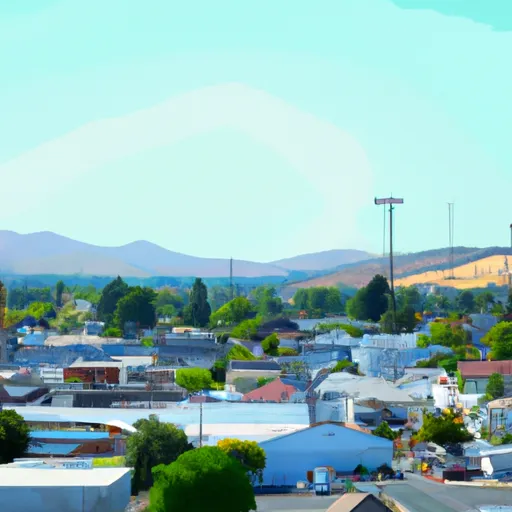-
 Snoflo Premium
Snoflo Premium
Get unlimited access to all our content
With no Ad interruptions! - Start Your Free Trial Login with existing account
Valley-Springs
Eden Index
Climate
9.5
•
Recreation
2.7
•
Community
1.9
•
Safeguard
5.2/10

Valley Springs is a charming community located in Calaveras County, California. It enjoys a Mediterranean climate, characterized by hot, dry summers and mild, wet winters. Summers in Valley Springs can be scorching, with temperatures frequently reaching over 100°F (38°C). Winters are relatively mild, with temperatures rarely dropping below freezing.
Hydrologically, Valley Springs is situated in the Sierra Nevada foothills and is part of the Calaveras River watershed. The region is known for its picturesque landscapes, including rolling hills, oak woodlands, and beautiful lakes. The area is home to various hydrological constituents, including creeks, streams, and the Calaveras River, providing residents and visitors with ample opportunities for water-based recreation such as fishing, boating, and swimming.
Outdoor enthusiasts will find plenty of activities to enjoy in Valley Springs. The surrounding area offers numerous hiking and biking trails, allowing visitors to explore the region's stunning natural beauty. The nearby New Hogan Lake is a popular spot for camping, picnicking, and water sports. Additionally, Valley Springs is conveniently located near the Calaveras Big Trees State Park, where visitors can marvel at the giant sequoia groves and enjoy activities like hiking, birdwatching, and camping.
What is the Eden Index?
The Snoflo Eden Index serves as a comprehensive rating system for regions, evaluating their desirability through a holistic assessment of climate health, outdoor recreation opportunities, and natural disaster risk, acknowledging the profound impact of these factors on livability and well-being.
Climate Health Indicator (CHI): 9.5
Valley-Springs receives approximately
554mm of rain per year,
with humidity levels near 72%
and air temperatures averaging around
16°C.
Valley-Springs has a plant hardyness factor of
9, meaning
plants and agriculture in this region tend to thrive here all year round.
By considering the ideal temperature range, reliable water supplies, clean air, and stable seasonal rain or snowpacks, the Climate Health Indicator (CHI) underscores the significance of a healthy climate as the foundation for quality living.
A healthy climate is paramount for ensuring a high quality of life and livability in a region, fostering both physical well-being and environmental harmony. This can be characterized by ideal temperatures, reliable access to water supplies, clean air, and consistent seasonal rain or snowpacks.
Weather Forecast
Streamflow Conditions
San Joaquin
Area Rivers
San Joaquin
Snowpack Depths
San Joaquin
Reservoir Storage Capacity
San Joaquin
Groundwater Levels
Recreational Opportunity Index (ROI): 2.7
The Recreational Opportunity Index (ROI) recognizes the value of outdoor recreational options, such as parks, hiking trails, camping sites, and fishing spots, while acknowledging that climate plays a pivotal role in ensuring the comfort and consistency of these experiences.
Access to outdoor recreational opportunities, encompassing activities such as parks, hiking, camping, and fishing, is crucial for overall well-being, and the climate plays a pivotal role in enabling and enhancing these experiences, ensuring that individuals can engage in nature-based activities comfortably and consistently.
Camping Areas
| Campground | Campsites | Reservations | Toilets | Showers | Elevation |
|---|---|---|---|---|---|
| Oak Knoll - New Hogan Lake | None | 716 ft | |||
| Woodward Reservoir | 155 | 219 ft | |||
| Indian Grinding Rock State Park | 22 | 2,378 ft | |||
| Acorn - New Hogan Lake | None | 699 ft |
Nearby Fishing
Nearby Ski Areas
Catastrophe Safeguard Index (CSI):
The Catastrophe Safeguard Index (CSI) recognizes that natural disaster risk, encompassing floods, fires, hurricanes, and tornadoes, can drastically affect safety and the overall appeal of an area.
The level of natural disaster risk in a region significantly affects safety and the overall livability, with climate change amplifying these risks by potentially increasing the frequency and intensity of events like floods, fires, hurricanes, and tornadoes, thereby posing substantial challenges to community resilience and well-being.
Community Resilience Indicator (CRI): 1.9
The Community Resilience Indicator (CRI) recognizes that education, healthcare, and socioeconomics are crucial to the well-being of a region. The CRI acknowledges the profound impact of these elements on residents' overall quality of life. By evaluating educational resources, healthcare accessibility, and economic inclusivity, the index captures the essential aspects that contribute to a thriving community, fostering resident satisfaction, equity, and social cohesion.

